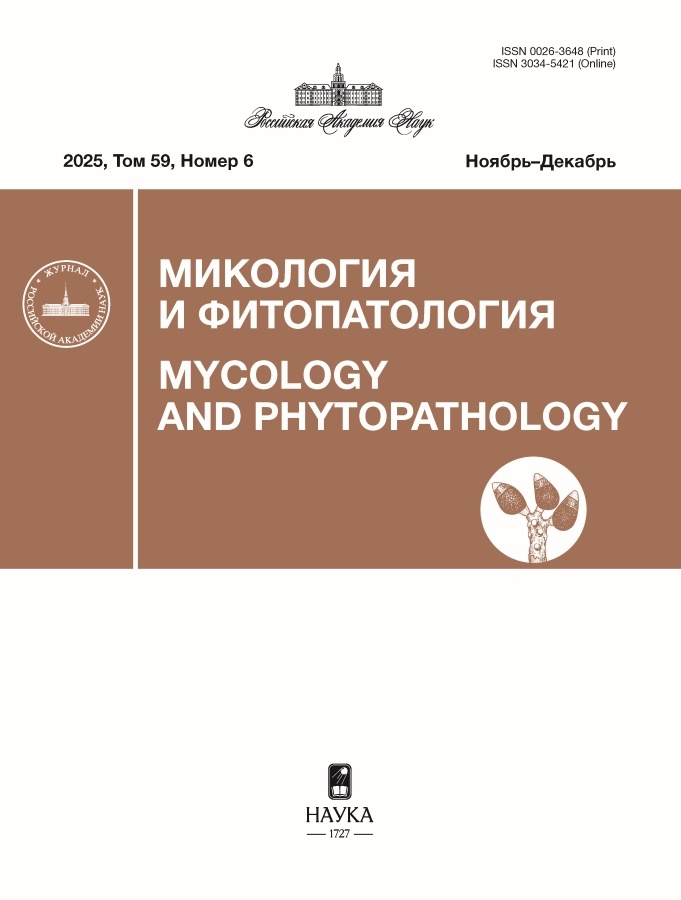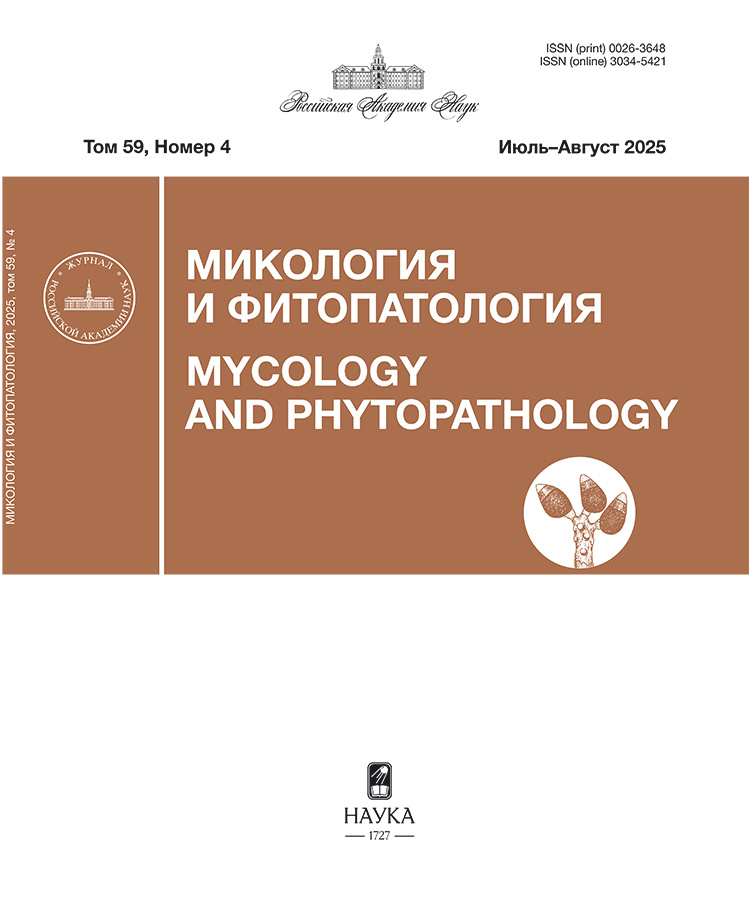Особенности формирования микобиоты угольных отвалов в высоких широтах по данным метагеномного исследования
- Авторы: Ильюшин В.А.1, Кирцидели И.Ю.1
-
Учреждения:
- Ботанический институт им. В. Л. Комарова РАН
- Выпуск: Том 59, № 4 (2025)
- Страницы: 271–278
- Раздел: БИОРАЗНООБРАЗИЕ, СИСТЕМАТИКА, ЭКОЛОГИЯ
- URL: https://transsyst.ru/0026-3648/article/view/687651
- DOI: https://doi.org/10.31857/S0026364825040013
- EDN: https://elibrary.ru/befwnw
- ID: 687651
Цитировать
Полный текст
Аннотация
Изучены особенности формирования микобиоты в породных отвалах угольных шахт и карьеров разного возраста с использованием метагеномных данных. Показана динамика комплексов грибов в ходе сукцессионного процесса в арктической тундре, южной тундре и лесотундре. Образцы породы были отобраны из отвалов в Баренцбурге (Шпицберген), Воркуте (Республика Коми) и Сусумане (Магаданская обл.). Результаты показывают, что биоразнообразие грибов в основном представлено отделом Ascomycota. В хроносериях отвалов обнаружена высокая доля грибов классов Eurotiomycetes, Dothideomycetes, Leotiomycetes, Agaricomycetes и Sordariomycetes. В хроносерии Шпицбергена выявлено 58 родов, республики Коми – 59 родов, в хроносерии Магаданской обл. – 65 родов. Показано, что сообщества в угольных отвалах разнообразны и изменяются в зависимости от возраста отвалов и природных зон Арктики. Также показано, что сообщества отвалов в пределах одной хроносерии имеют между собой большее сходство, чем с сообществами отвалов других природных зон.
Полный текст
Об авторах
В. А. Ильюшин
Ботанический институт им. В. Л. Комарова РАН
Автор, ответственный за переписку.
Email: ilva94@yandex.ru
Россия, Санкт-Петербург
И. Ю. Кирцидели
Ботанический институт им. В. Л. Комарова РАН
Email: microfungi@mail.ru
Россия, Санкт-Петербург
Список литературы
- Abakumov E.V. Accumulation and transformation of organic matter in different-aged dumps from sand quarries. Eurasian Soil Sci. 2008. V. 41. P. 844–851. https://doi.org/10.1134/S1064229308080061
- Detheridge A.P., Comont D., Callaghan T.M. et al. Vegetation and edaphic factors influence rapid establishment of distinct fungal communities on former coal-spoil sites. Fungal Ecol. 2018. V. 33. P. 92–103. https://doi.org/10.1016/j.funeco.2018.02.002
- Domsch K.H., Gams W., Anderson T.H. Compendium of soil fungi. IHW-Verlag, Eching, 2007.
- Elhottova D., Kristufek V., Frouz J. et al. Screening for microbial markers in Miocene sediment exposed during open-cast brown coal mining. Antonie Van Leeuwenhoek. 2006. V. 89. P. 459–463.
- Evans H.C. Thermophilous fungi of coal spoil tips. Occurrence, distribution and temperature relationships. Trans. Br. Mycol. Soc. 1971. V. 57. P. 255–266.
- Fungal metagenomic sequencing. demonstrated protocol. 2025. https://support.illumina.com/content/dam/illumina-support/documents/documentation/chemistry_documentation/metagenomic/fungal-metagenomic-demonstrated-protocol-1000000064940-01.pdf. Accessed 10.01.2025.
- Fungal sequencing and classification with the ITS metagenomics protocol. 2018. https://www.illumina.com/content/dam/illumina-marketing/documents/products/appnotes/its-metagenomics-app-note-1270-2018-001-web.pdf. Accessed 10.01.2025.
- Gadd G.M. Metals, minerals and microbes: geomicrobiology and bioremediation. Microbiology. 2010. V. 156. P. 609–643. https://doi.org/10.1099/mic.0.037143-0
- Gräfenhan T., Schroers H.-J., Nirenberg H.I. et al. An overview of the taxonomy, phylogeny, and typification of nectriaceous fungi in Cosmospora, Acremonium, Fusarium, Stilbella, and Volutella. Stud. Mycol. 2011. V. 68. P. 79– 113. https://doi.org/10.3114/sim.2011.68.04
- Hugenholtz P., Goebel B.M., Pace N.R. Impact of culture-independent studies on the emerging phylogenetic view of bacterial diversity. Journal of bacteriology. 1998. V. 180 (18). P. 4765–4774.
- Iliushin V.A. First find of Cadophora antarctica Rodr.-Andrade, Stchigel, Mac Cormack et Cano in the Arctic. Czech Polar Reports. 2020. V. 10 (2). P. 147–152. https://doi.org/10.5817/CPR2020-2-11
- Iliushin V.A., Kirtsideli I.Y. Dynamics of complexes of microscopic fungi in the process of overgrowing spoil tips of coal mines in the southern tundra zone (Komi Republic). Mikologiya i fitopatologiya. 2021. V. 55 (2). P. 129–137. https://doi.org/10.31857/S0026364821020045
- Iliushin V.A., Kirtsideli I.Y., Sazanova N.A. Diversity of microfungi of coal mine spoil tips in the Magadan Region, Russia. Current Research in Environmental and Applied Mycology (Journal of Fungal Biology). 2022b. V. 12 (1). P. 136–146. https://creamjournal.org/pdf/CREAM_12_1_11.pdf
- Iliushin V.A., Kirtsideli I.Y., Vlasov D. Yu. Diversity of culturable microfungi of coal mine spoil tips in Svalbard. Polar Science. 2022a. V. 32. e100793. https://doi.org/10.1016/j.polar.2022.100793
- Ji C., Huang J., Yu H. et al. Do the reclaimed fungal communities succeed toward the original structure in eco-fragile regions of coal mining disturbances? A case study in North China Loess-Aeolian sand area. Front. Microbiol. 2022. V. 13. e770715. https://doi.org/10.3389/fmicb.2022.770715
- Khabibullina F.M., Kuznetsova E.G., Panyukov A.N. Transformation of vegetation, soils, and soil microbiota in the impact zone of the coal mine “Vorkutinskaya”. Theoretical and Applied Ecology. 2015. V. 4. P. 30–37. (In Russ.). https://doi.org/10.25750/1995-4301-2015-4-030-037
- Kompała-Bąba A., Bierza W., Błonska A. et al. Vegetation diversity on coal mine spoil heaps – how important is the texture of the soil substrate? Biologia. 2019. V. 74. P. 419–436. https://doi.org/10.2478/s11756-019-00218-x
- Krause-Jensen D., Duarte C.M. Expansion of vegetated coastal ecosystems in the future Arctic. Front. Mar. Sci. 2014. V. 1. Art. 77. https://doi.org/10.3389/fmars.2014.00077
- Marescotti P., Roccotiello E., Zotti M. et al. Influence of soil mineralogy and chemistry on fungi and plants in a waste-rock dump from the Libiola mine (eastern Liguria, Italy). Periodico di Mineralogia. 2013. V. 82. P. 141–162.
- Quast C., Pruesse E., Yilmaz P. The SILVA ribosomal RNA gene database project: Improved data processing and web-based tools. Nucleic Acids Res. 2013. V. 41. D590–D596. https://doi.org/10.1093/nar/gks1219
- Ruiz-Jaen M.C., Mitchell Aide T. Restoration success: how is it being measured? Restor. Ecol. 2005. V. 13. P. 569–577. https://doi.org/10.1111/j.1526-100X.2005.00072.x
- Sazanova K.V., Zelenskaya M.S., Vlasov A.D. et al. Microorganisms in superficial deposits on the stone monuments in Saint Petersburg. Microorganisms. 2022. V. 10. P. 316. https://doi.org/10.3390/microorganisms10020316
- Stevens J. Applied multivariate statistics for the social sciences. Erlbaum, Hillsdale, 1986.
- Ulfig K., Korcz M. Isolation of keratinolytic fungi from a coal mine dump. Mycopathologia. 1995. V. 129. P. 83–86. https://doi.org/10.1007/BF01103466
- Vlasov D.Y., Abakumov E.V., Nadporozhskaya M.A. et al. Lithosols of king george island, western Antarctica. Eurasian Soil Sci. 2005. V. 38. P. 681–687.
- Wise D.L. Bioprocessing and biotreatment of coal. Marcel Dekker, N.Y., 1990.
- Хабибуллина Ф.М., Кузнецова Е.Г., Панюков А.Н. (Khabi-bullina et al.) Трансформация растительности, почв и почвенной микробиоты в зоне воздействия породных отвалов угольной шахты “Воркутинская” // Теоретическая и прикладная экология. 2015. № 4. С. 30–37.
Дополнительные файлы












